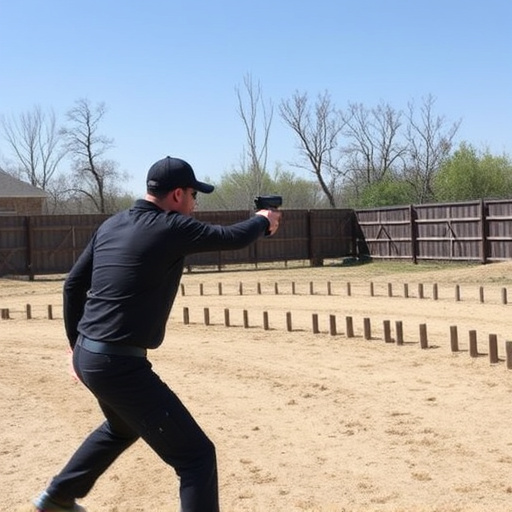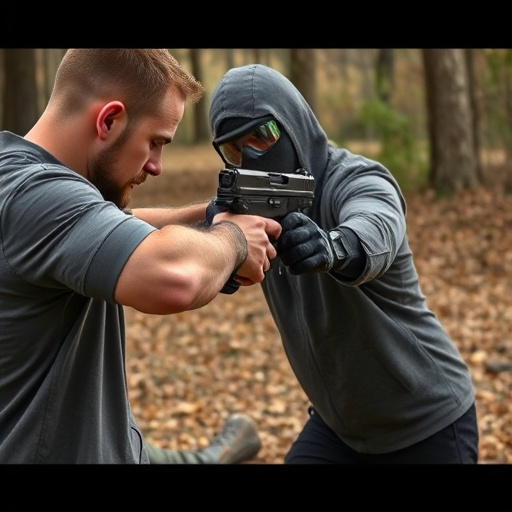Compact stun guns with flashlights rely on voltage to penetrate fabrics and immobilize attackers, but fabric thickness and composition significantly affect their effectiveness. Thicker materials like kevlar or leather provide better protection against electric shock compared to lighter fabrics. These devices offer a powerful deterrent for personal safety in close-quarters or high-risk situations, but proper training, understanding fabric types, and local laws are essential for safe use. Regular maintenance ensures optimal performance when needed.
Voltage penetration through thick clothing is a fascinating yet often overlooked aspect of electrical safety. This article delves into the intricate world of voltage behavior, exploring how it interacts with different materials. We dissect the role of clothing thickness in voltage transmission and shine a light on compact stun guns with flashlights—a growing trend in personal protection. Additionally, we cover essential safety considerations to ensure informed usage, providing practical best practices for navigating this unique challenge.
- Understanding Voltage and Its Behavior
- The Role of Clothing Thickness in Voltage Transmission
- Compact Stun Guns with Flashlights: A Closer Look
- Safety Considerations and Best Practices
Understanding Voltage and Its Behavior

Voltage, a measure of electric potential difference, is a fundamental concept in electronics and electricity. When it comes to understanding how it interacts with various materials, including thick clothing, it’s crucial to consider its behavior at different levels. In simple terms, voltage represents the force that pushes electrical charges through a conductor or insulator. It determines the ease with which an electric current flows, which is why knowing its properties is essential when examining issues like penetration through protective layers.
In the context of compact stun guns with flashlights, for instance, users should be aware that voltage’s ability to penetrate clothing varies significantly based on fabric thickness and composition. While these devices utilize high-voltage outputs to deliver powerful shocks, their effectiveness against well-structured garments is limited. Thick fabrics act as insulators, slowing down the flow of electric current, thus reducing the impact of the voltage. This phenomenon highlights the importance of considering not just the power source but also the material barriers that could affect the device’s performance.
The Role of Clothing Thickness in Voltage Transmission

The thickness of clothing plays a significant role in determining how effectively voltage penetrates and is conducted through it. In general, thicker fabrics or materials tend to obstruct the flow of electrical current more than thinner ones. This is because the charge carriers, such as electrons, face increased resistance when traversing a denser material. For instance, a compact stun gun with flashlight designed for self-defense would see its effectiveness reduced if targeted at well-clad individuals due to the thicker clothing acting as a barrier.
Clothing thickness can vary widely depending on the type of fabric and even the layering of garments. Heavy duty or high density fabrics like kevlar or leather provide more protection against electrical penetration than lighter cotton or synthetic materials. Understanding this relationship between clothing thickness and voltage transmission is crucial for safety considerations, especially when dealing with potential threats that involve electric shock or stun devices like compact stun guns with flashlight.
Compact Stun Guns with Flashlights: A Closer Look

Compact stun guns with flashlights offer a multifaceted tool for personal safety, combining the power of a stun device with the illumination of a flashlight in a single, portable unit. These devices are designed to be easily concealable and accessible, making them appealing choices for individuals seeking protection while out and about. The built-in flashlight not only aids in low-light conditions but also serves as a deterrent, allowing users to signal for help or illuminate potential hazards.
The integration of a stun function into these compact tools enhances their effectiveness in self-defense scenarios. With a simple activation, the device delivers a powerful electric shock that can temporarily incapacitate an assailant, providing valuable time for escape or assistance. Moreover, the combination of stun and flashlight functionality makes them versatile tools suitable for various situations, from outdoor adventures to late-night walks, ensuring users are prepared and protected.
Safety Considerations and Best Practices

When considering self-defense options, especially in close-quarters or high-risk situations, understanding voltage penetration through clothing is vital. While it might seem like a novel concept, compact stun guns with integrated flashlights offer a unique advantage in these scenarios. These devices not only provide illumination but can also penetrate thick fabrics to deliver an electric shock, temporarily disabling an aggressor.
Safety should always be the top priority when employing such tools. It’s crucial to remember that voltage penetration varies depending on fabric thickness and type. Lightweight, breathable materials allow for better current flow compared to dense, insulated fabrics. Users of compact stun guns with flashlights must ensure proper training, as incorrect application could lead to injury or ineffectiveness. Best practices include keeping the device readily accessible, practicing safe handling, and understanding local laws regarding self-defense tools. Regular maintenance and testing of the device are also essential to guarantee optimal performance when needed.
In understanding voltage penetration through thick clothing, it’s clear that factors like garment composition and thickness significantly influence electricity flow. This article has explored these dynamics, highlighting the importance of considering clothing as a barrier or conduit for electrical energy. Notably, compact stun guns with flashlights, a growing trend in personal safety devices, operate within these parameters. By adhering to safety considerations and best practices, users can effectively leverage these tools. Moving forward, continued research into material science and electrical engineering will further refine our knowledge of voltage transmission, leading to enhanced safety measures for everyday applications, including compact stun guns with flashlights.
